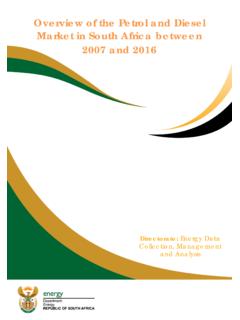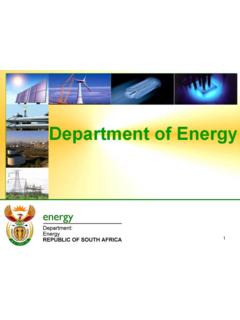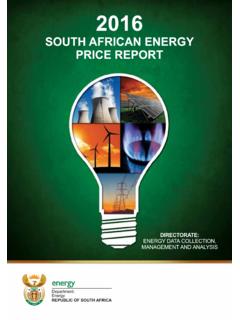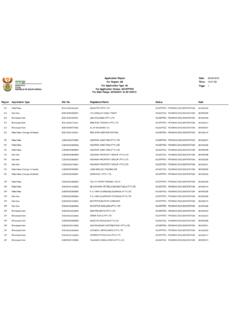Transcription of NON GRID HH ELECTRIFICATION POLICY …
1 Date: 19/03/2012 CONTENTS PAGE 1. 3 2. Objective of the 4 3. Scope of 5 4. The non- grid ELECTRIFICATION 5 The criteria for non- grid 6 5. Non- grid ELECTRIFICATION through concessionaires .. 7 6. Non- grid ELECTRIFICATION programme 8 The application process for 9 7. Funding .. 10 The funding model: Fee-for-service model .. 10 The 10 Free Basic 11 8. Contractual 12 Contracts .. 12 Level of service 12 Re-use of deinstalled solar home 13 9. 13 10. Monitoring and 13 11. Community awareness and 13 1. Introduction Government has a responsibility to ensure the ELECTRIFICATION of all its citizens, particularly, the poor in rural areas, to uplift the people and make life a little easier.
2 It is widely recognized that access to and supply to modern energy plays an important role in poverty alleviation and sustainable development. Access to electricity can bring many positive impacts including poverty alleviation and improved child education. Government supports the concept of energisation , for the purposes of widening access, to a safe and effective energy package, within grasp of the low-income consumer and will promote its implementation where appropriate. Universal household access to electricity is one of the cornerstones of the White Paper on Energy POLICY . The connections made during the ELECTRIFICATION programme (1994 to date), were mainly in the urban areas. This disparity in the provision of electricity to households can be attributed to the increasingly high cost of extending the grid to rural areas that are remote from the existing network; low density of houses; low electricity consumption; and bad terrains.
3 The Department of Energy (DoE) is committed to providing access to energy to 92% of formal South African households by 2014. grid electricity is the preferred method of energisation. 82% of formal South African households are already connected. Of the 18% not yet electrified, a majority of these households are in deep rural areas. The most suitable method of electricity provision depends on a combination of the geographical context, the consumer needs, and the possibilities that are available and affordable to provide the energy requirements. The rising cost of material and the ever increasing costs of electricity makes grid ELECTRIFICATION more and more uneconomical. The low load demand, the dispersed nature of rural settlements, and the high fixed costs of grid extensions makes it unlikely that grid will reach most areas in the medium term.
4 Furthermore, the call to reduce carbon emissions makes off grid ELECTRIFICATION more attractive. There are also environmental issues such as a positive impact on pollution. There are also health and safety benefits in relation to risks associated with the use of paraffin, candles and wood which is very common in unelectrified rural households. It is widely acknowledged that the grid ELECTRIFICATION programme currently fails to recover the operational costs of supplying electricity to rural communities. Provision of grid electricity of households in rural areas is likely to be uneconomical and unsustainable in the long term. The non grid Solar Home Systems (SHS) have been identified as a suitable temporary alternative to grid electricity.
5 The SHS offers both a technologically and viable alternative, providing basic electricity for essential services such as quality lighting and access to the electronic media to the rural consumer, where grid cannot be provided within reasonable cost norms. The integration of the available ELECTRIFICATION technologies and electricity supply options on the basis of the most economical application will allow the provision of basic energy services to a larger portion of the population in the shortest possible time within the constraints of available funding. It is regarded as the only viable way of bringing the goal of sustainable "universal access to electricity" within reach over the longer term. 2. Objective of the POLICY The objective of this document is to provide POLICY guidelines for the provision of non- grid ELECTRIFICATION to households as part of the Integrated National ELECTRIFICATION Programme.
6 3. Scope of application These POLICY guidelines are applicable to all licensed entities, concessionaires, and service providers (energy-service-company: ESCO) providing non- grid ELECTRIFICATION to households on behalf of the Department of the Energy. 4. The non- grid ELECTRIFICATION programme Households in rural areas are typically sparsely settled, which makes the extension of grid networks to connect those areas economically unviable. The ELECTRIFICATION programme would not be able to ensure grid ELECTRIFICATION of all remote rural areas in the short or medium-term, therefore non- grid ELECTRIFICATION was identified as an alternative. The non- grid ELECTRIFICATION programme is designed to temporarily give deep rural communities access to limited electricity until such time that grid connections are possible.
7 Solar Home Systems (SHS) are given to households as part of the non- grid ELECTRIFICATION programme. A solar home system is an environmentally friendly technology and it involves low operation and maintenance costs. The solar home system is designed to serve one individual household. The basic solar home system to be used would comprise the following: A photovoltaic (PV) panel (50Wp), A charge controller, Wiring & outlets for small appliances A battery (105 Amp-hour) 4 energy efficient compact fluorescent lights (CFLs) One 50W panel equates to approximately 250Wh/day. The solar home systems must satisfy the specification NRS 052 photovoltaic systems for use in individual homes. Deviations from this specification may be accepted, provided such deviations are clearly explained, reasons for the deviations given and support warranties issued.
8 Experience from previous ELECTRIFICATION projects in rural areas has shown that initially, customer use very little electricity. The main cause of low consumption is limited financial resources due to the poverty levels in the rural areas. The solar system allows for the use of a black and white television for four hours; four hours of quality lighting using high efficiency lights; the use of a portable radio for ten hours; and charging of cellphones. However, the thermal energy needs of solar off- grid customers, such as cooking, heating, ironing and refrigeration are not met. Other energy sources such as firewood and biomass, coal, paraffin, oil and liquid petroleum gas have to be used. Therefore one of the requirements of the Department of Energy is that the suppliers of non- grid technologies should augment their services by selling thermal fuels such as paraffin and Liquefied Petroleum Gas (LPG) to meet the cooking needs.
9 The criteria for non- grid ELECTRIFICATION Prior to providing non- grid ELECTRIFICATION to certain areas, communities or households, the following conditions must be met: The lowest capacity grid supply cannot be supplied within the capital expenditure limit Non grid systems should not be installed within 2km from a grid line. Consider future grid ELECTRIFICATION plans. The area falls outside of the 3 year grid plan. The identified areas must be included in the Municipal IDP. Eskom or licensed distributor in that area must confirm areas or households that would not receive grid electricity in the foreseeable future and grant permission that non- grid ELECTRIFICATION be provided in those areas. A cost benefit analysis will also be considered to determine whether an area will be electrified via non- grid or not.
10 The cost of reticulation is extremely high in rural areas because there are no bulk infrastructure lines in most cases and the population density in deep rural areas makes grid ELECTRIFICATION extremely uneconomical. The cost of supply must be compared against the lowest grid supply option available to more dense settlements. 5. Non- grid ELECTRIFICATION through Concessionaires Government alone cannot address energy poverty issues. It has been recognized that there is a need to involve the private sector and create public-private partnerships in service delivery. This has been done through the involvement of concessionaires in the provision of non- grid ELECTRIFICATION to rural households. Non- grid ELECTRIFICATION through concessionaires was launched in 2001 by the then Department of Minerals and Energy, to provide energy services to remote rural areas.














